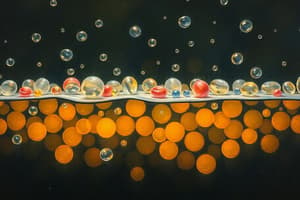Podcast
Questions and Answers
What is the primary role of the cell membrane?
What is the primary role of the cell membrane?
- To control what enters and exits the cell. (correct)
- To produce energy for the cell.
- To store genetic information.
- To synthesize proteins.
Which of the following describes the structure of the cell membrane?
Which of the following describes the structure of the cell membrane?
- A bi-layer of phospholipids with embedded proteins. (correct)
- A rigid wall of carbohydrates.
- A single layer of proteins.
- A fluid mosaic of nucleic acids.
What property characterizes the hydrophobic tails of phospholipids in a cell membrane?
What property characterizes the hydrophobic tails of phospholipids in a cell membrane?
- They repel water and are insoluble. (correct)
- They attract ions.
- They are attracted to water.
- They are soluble in water.
How does cholesterol contribute to the cell membrane's function?
How does cholesterol contribute to the cell membrane's function?
What role do proteins primarily play in the cell membrane?
What role do proteins primarily play in the cell membrane?
How do carbohydrates contribute to the function of the cell membrane?
How do carbohydrates contribute to the function of the cell membrane?
Which statement accurately describes the Fluid Mosaic Model of the cell membrane?
Which statement accurately describes the Fluid Mosaic Model of the cell membrane?
Why is the arrangement of phospholipids into a bi-layer essential for cell membrane function?
Why is the arrangement of phospholipids into a bi-layer essential for cell membrane function?
How do saturated and unsaturated fatty acid tails affect membrane fluidity?
How do saturated and unsaturated fatty acid tails affect membrane fluidity?
What is the main difference between integral and peripheral membrane proteins?
What is the main difference between integral and peripheral membrane proteins?
What role do transmembrane proteins play within the cell membrane?
What role do transmembrane proteins play within the cell membrane?
Which of the following is a primary function of membrane proteins related to cellular communication?
Which of the following is a primary function of membrane proteins related to cellular communication?
Why is the cell membrane described as selectively-permeable?
Why is the cell membrane described as selectively-permeable?
What is the key difference between passive and active transport?
What is the key difference between passive and active transport?
In which direction do molecules move during diffusion?
In which direction do molecules move during diffusion?
What is the role of transport proteins in facilitated diffusion?
What is the role of transport proteins in facilitated diffusion?
What is osmosis?
What is osmosis?
Which condition defines a hypertonic solution relative to a cell?
Which condition defines a hypertonic solution relative to a cell?
Which process requires a cell to expend energy (ATP)?
Which process requires a cell to expend energy (ATP)?
What is the primary role of the sodium-potassium pump in nerve cells?
What is the primary role of the sodium-potassium pump in nerve cells?
What is the purpose of bulk transport?
What is the purpose of bulk transport?
Which direction do substances move during endocytosis?
Which direction do substances move during endocytosis?
What distinguishes phagocytosis from other types of endocytosis?
What distinguishes phagocytosis from other types of endocytosis?
What is the primary difference between exocytosis and endocytosis?
What is the primary difference between exocytosis and endocytosis?
How does receptor-mediated endocytosis differ from pinocytosis?
How does receptor-mediated endocytosis differ from pinocytosis?
Which of the following transport mechanisms is responsible for the secretion of hormones from endocrine glands?
Which of the following transport mechanisms is responsible for the secretion of hormones from endocrine glands?
What is the effect of placing a cell with an internal salt concentration of 0.5% into a solution with a salt concentration of 1.5%?
What is the effect of placing a cell with an internal salt concentration of 0.5% into a solution with a salt concentration of 1.5%?
If a cell needs to import a large, polar molecule that is too large to pass through a transport protein, which mechanism would it most likely use?
If a cell needs to import a large, polar molecule that is too large to pass through a transport protein, which mechanism would it most likely use?
Which of the following is an example of a substance that would likely cross the cell membrane via simple diffusion?
Which of the following is an example of a substance that would likely cross the cell membrane via simple diffusion?
What immediate effect would a decrease in environmental temperature have on a cell membrane with a high proportion of saturated fatty acids?
What immediate effect would a decrease in environmental temperature have on a cell membrane with a high proportion of saturated fatty acids?
What happens if you place a cell in a hypotonic solution?
What happens if you place a cell in a hypotonic solution?
What is the purpose of membrane carbohydrates?
What is the purpose of membrane carbohydrates?
How does the cell membrane help cells maintain homeostasis?
How does the cell membrane help cells maintain homeostasis?
What can prevent water from leaving or entering the cell?
What can prevent water from leaving or entering the cell?
Where would you expect to find glycoproteins and glycolipids?
Where would you expect to find glycoproteins and glycolipids?
What type of molecules cannot move through the lipid bi-layer?
What type of molecules cannot move through the lipid bi-layer?
Where are peripheral membrane proteins typically found?
Where are peripheral membrane proteins typically found?
What role do integral proteins play in the cell membrane?
What role do integral proteins play in the cell membrane?
What happens during exocytosis?
What happens during exocytosis?
If you introduce a cell to an isotonic solution, what happens to it?
If you introduce a cell to an isotonic solution, what happens to it?
Flashcards
Function of cell membrane
Function of cell membrane
Cell membranes or plasma membranes control what gets in and out of cells, facilitate communication, and allow cells to get food and let waste out.
Cell membrane structure
Cell membrane structure
The cell membrane is composed of two layers of phospholipids.
Hydrophilic head
Hydrophilic head
The head is water-attracting and soluble in water.
Hydrophobic tails
Hydrophobic tails
Signup and view all the flashcards
3 main components of the cell membrane
3 main components of the cell membrane
Signup and view all the flashcards
Fluid Mosaic Model
Fluid Mosaic Model
Signup and view all the flashcards
Lipids
Lipids
Signup and view all the flashcards
Proteins
Proteins
Signup and view all the flashcards
Carbohydrates in cell membrane
Carbohydrates in cell membrane
Signup and view all the flashcards
Phospholipid hydrophilic head
Phospholipid hydrophilic head
Signup and view all the flashcards
Phospholipid hydrophobic tail
Phospholipid hydrophobic tail
Signup and view all the flashcards
Reasons for Structure
Reasons for Structure
Signup and view all the flashcards
Saturated vs. unsaturated fatty acid tails
Saturated vs. unsaturated fatty acid tails
Signup and view all the flashcards
Cholesterol in the cell membrane
Cholesterol in the cell membrane
Signup and view all the flashcards
Functions of Proteins in Membranes
Functions of Proteins in Membranes
Signup and view all the flashcards
Integral Membrane Proteins
Integral Membrane Proteins
Signup and view all the flashcards
Peripheral Membrane Proteins
Peripheral Membrane Proteins
Signup and view all the flashcards
Glycoprotein
Glycoprotein
Signup and view all the flashcards
Glycolipid
Glycolipid
Signup and view all the flashcards
Membrane Permeability
Membrane Permeability
Signup and view all the flashcards
Passive Transport
Passive Transport
Signup and view all the flashcards
Active Transport
Active Transport
Signup and view all the flashcards
Transport across the membrane
Transport across the membrane
Signup and view all the flashcards
Passive: Diffusion
Passive: Diffusion
Signup and view all the flashcards
Facilitated Diffusion
Facilitated Diffusion
Signup and view all the flashcards
Osmosis
Osmosis
Signup and view all the flashcards
Isotonic
Isotonic
Signup and view all the flashcards
Hypertonic
Hypertonic
Signup and view all the flashcards
Hypotonic
Hypotonic
Signup and view all the flashcards
Active Transport
Active Transport
Signup and view all the flashcards
Bulk Transport
Bulk Transport
Signup and view all the flashcards
Phagocytosis
Phagocytosis
Signup and view all the flashcards
Pinocytosis
Pinocytosis
Signup and view all the flashcards
Receptor-mediated endocytosis
Receptor-mediated endocytosis
Signup and view all the flashcards
Exocytosis
Exocytosis
Signup and view all the flashcards
Study Notes
- Cell membranes, also known as Plasma membranes, regulate the movement of substances into and out of the cell
- Cells require the import of food and the export of waste
- Communication also occurs at the cellular level
Cell Membrane Structure
- The cell membrane consists of a bi-layer of phospholipids
- The phospholipid has two components:
- A hydrophillic head that attracts water and is water soluble
- Hydrophobic tails that repel water and are insoluble in water
3 Main Components of Cell Membranes
- Lipids is a main component
- Proteins facilitate transport
- Carbohydrates facilitate communication
Fluid Mosaic Model
- The cell membrane is considered a dynamic model wherein components move freely
Phospholipids
- Hydrophilic head: Is negatively charged, contains a polar phosphate group, and faces outwards
- Hydrophobic tail: Consists of fatty acids that tuck into the membrane's interior to avoid water
Reasons for Cell Membrane Structure
- Water exists both outside the cell and inside the cell
- Hydrophilic heads are in contact only with water
- Hydrophobic lipid tails never contact water
- Cell membrane structure blocks substances from passing through
Membrane Fluidity
- Saturated fatty acid tails pack together while unsaturated fatty acid tails cannot pack together
- Saturated fatty acid tails allows molecules to pack together more densely at cooler temperatures
- Unsaturated fatty acid tails cannot pack together due to double bonds, thus remaining fluid at lower temperatures
Cholesterol
- Found alongside phospholipids in the membrane
- Acts as a membrane stabilizer
- Minimizes temperature effects
- At low temperatures it keeps the phospholipids from packing together
Proteins
- Function as transport
- Function as enzymes
- Facilitate signaling by binding to chemicals to trigger changes on the inner surface
- Attachment points for cytoskeleton support
- Recognize microbes for immune response.
Integral Membrane Proteins
- Embedded within the membrane
- One region is anchored to the hydrophobic core
- Span part of- or all the way through the membrane
- Transmembrane Proteins span the entire membrane
Peripheral Membrane Structure
- Found on the outer or inner surface
- Does not touch the hydrophobic core
- Located mostly on the cytosol side
- Some part of cytoskeleton
Carbohydrates
- Found on the outer surface (extracellular)
- Glycoprotein is bound to a protein
- Glycolipid is bound to a lipid
- Cellular markers enable functions such as:
- Cell-to-cell recognition
- Immune response
Membrane Permeability
- Membranes can be semi-permeable or selectively-permeable
- Membranes control what comes in and goes out
- Some substances can pass in and out easily
- Some require special structures
- Some require energy
Types of Transport
- Passive transport: movement without energy use
- Active: movement with energy use
Transport Across the Membrane
- Passive Transport
- Facilitated Diffusion
- Active Transport
- Endocytosis
- Exocytosis
Transport Summary
- Simple diffusion: Driven by a concentration gradient without the need of ATP
- Common substances include nonpolar compounds, lipids, oxygen, and carbon dioxide
- Facilitated diffusion: Driven by a concentration gradient without the need of ATP
- Common substances include polar compounds, water, ions such as Na+ and Cl-, and glucose
- Active Transport: Requires ATP
- Vesicle Transport: Moves larger quantities of small molecules
Passive: Diffusion
- Molecules move from areas of high concentration to areas of low concentration until equilibrium is reached
- Two types:
- Simple Diffusion
- Facilitated Diffusion
Passive Transport
- Molecules move from areas of high concentration to areas of low concentration without energy investment
- In simple diffusion, the concentration gradient moves from high to low concentration
- Lipid bilayers allow small uncharged polar molecules to pass through
Facilitated Diffusion
- Transport proteins protect charged/polar molecules from hydrophobic core by providing a route through the membrane
- Diffusion "helped" by membrane proteins
- Transport proteins are used for charged and polar molecules
- Transport proteins protect charged/polar molecules from hydrophobic core by providing a route through the membrane.
Types of Proteins used in Facilitated Diffusion
- Channel
- Aquaporins
- Carrier proteins
Types of Passive Transport
- Osmosis is the passive diffusion of water across a membrane
- Requires water movement from a high concentration to a low concentration
- Moves water from a lower solute concentration to a higher solute concentration
Passive Transport: Osmosis
- Three Solution descriptions:
- Hypotonic Solution
- Isotonic Solution
- Hypertonic Solution
Isotonic
- Solute concentration is equal inside and outside the cell
Hypertonic
- The concentration of solute molecules outside the cell is higher than the concentration in the cytoplasm
Hypotonic
- The concentration of a solute molecules inside the cell is higher than the concentration outside the cell
Active Transport
- The cell expends energy (ATP)
- Moves materials against the concentration gradient by using a protein pump
Pumps in the Nervous system
- Pumps 3 sodium out and 2 potassium in
- Protein goes back and forth between 2 shapes
- Inward facing has a high affinity for Na+
- Outward facing has a high affinity for K+
- Plays a major role in establishing membrane voltage
Bulk Transport
- Large particles (or large quantities of small particles) are transported across the membrane
- Substances enclose in their own small globes of membrane
Endocytosis - Bringing IN
- Phagocytosis: Fuses solids with a lysosome for digestion
- Pinocytosis: Brings in liquids; both are non-specific processes
- Receptor-mediated endocytosis: bringing in cholesterol; SPECIFIC
Exocytosis - Bringing OUT
- Vesicles fuse with the plasma membrane releasing contents to exterior of cell
- Includes hormones released from endocrine glands or digestive juice from pancreas
- Active Transport to export substances out of cell
Endocytosis
- Moves particles in by enclosing them in a vesicle made out of plasma membrane
- Substances are trapped in a pit/depression which pinches off, trapping the particles
- This includes phagocytosis and pinocytosis
Receptor-Mediated Endocytosis
- Used to capture a specific target molecule using receptor proteins on the cell surface
- Receptors act as proteins clustered in “coated pits", such as LDL cholesterol
Phagocytosis
- Used in cells to engulf bacteria, viruses, parts of dead cells, etc
- Ex: macrophages (white blood cells)
Studying That Suits You
Use AI to generate personalized quizzes and flashcards to suit your learning preferences.



